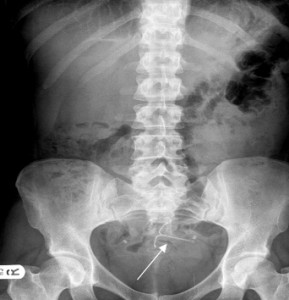Migration of Mirena IUD
The Mirena IUD, or intrauterine device, is a highly effective form of birth control manufactured by Bayer. But it’s also a device that, according to reports from some women who have used it, comes with potentially dangerous, even life-threatening risks. One of these risks is device migration, also known as extrauterine migration. Mirena migration occurs when the IUD device moves from its proper position in the uterus and embeds itself in the abdomen or uterine wall. Migration of the Mirena IUD may require surgical repair.
Mirena side effects are not only painful, but can also cause serious harm. Migration can result in uterine perforation – when the device burrows into and through the uterine wall. In the worst cases, the device continues its journey through a woman’s internal organs, damaging the bladder, pelvis, blood vessels, or other abdominal organs. Affected women can experience not only excruciating pain, but dangerous infection and organ damage.
As a result, many injured women choose to file a Mirena IUD lawsuit to recover the costs of medical bills, as well as economic and other damages from their injuries.
Symptoms of Mirena migration
The risks associated with Mirena migration are exacerbated by the fact that the condition can be difficult to identify. In fact, many women may not know there is a problem until they visit their doctor. A medical exam will diagnose a missing device string, which is an indication that the IUD is no longer in its correct position.
For optimal sexual health, and to ensure protection against unwanted pregnancy, all women implanted with the Mirena IUD should schedule regular follow-ups with their gynecologists, and should have their devices replaced every five years.
Increased risk of migration of Mirena IUD
Once Mirena migration has been diagnosed, the condition must be handled quickly to prevent further migration or organ perforation.
Delay in treating Mirena IUD migration could lead to serious complications, including:
- Intestinal obstructions
- Adhesions
- Abscesses
- Peritonitis
- Intestinal perforations
- Perforation of the uterus
The risk of complications is especially high in women who have given birth, and even higher in women who are breastfeeding. Complications are most common for the first six months following childbirth; to reduce the risks of migration and other Mirena side effects, women are advised to wait a minimum of six weeks following delivery before undergoing IUD insertion.
Additionally, it is unknown whether a first- or second-trimester abortion can increase a woman’s risk of side effects. At minimum, doctors recommend a six-week waiting period after a second-trimester abortion for Mirena insertion.
Treatment for Mirena perforation
Mirena migration necessitates device removal. Depending on the severity of the condition, difficult and risky surgery may be required to remove an IUD that has embedded in the uterine wall, or in other organs.
Other Mirena side effects
While device migration and organ perforation are some of the most dangerous Mirena side effects, the device is also linked to other severe complications:
- Device expulsion: Approximately 6 percent of Mirena recipients report device expulsion, or an IUD that spontaneously dislodges from its proper position. In addition to symptoms like unexplained cramping, pain during sexual intercourse, and bleeding, a woman who has experienced Mirena expulsion is not protected against pregnancy.
- Ectopic pregnancy: Though the Mirena IUD is designed to prevent pregnancy, pregnancy can still occur. Of all Mirena pregnancies, 50 percent are ectopic, or tubal pregnancies. Ectopic pregnancies can be life-threatening, and may require surgery. In some women, ectopic pregnancies result in infertility.
- Pelvic inflammatory disease: Pelvic inflammatory disease, or PID, results from a bacterial infection in the female reproductive system. Some of the long-term effects of PID include damaged reproductive organs (uterus, fallopian tubes, and ovaries) and infertility.
- Pregnancy complications: If a woman gets pregnant while she has a Mirena IUD in place, she may experience miscarriage, sepsis (infection), or premature delivery. It is often recommended that the zygote (fertilized egg) be removed surgically, to prevent septic abortion.
Minor side effects include breast tenderness, moodiness, acne, weight loss, weight gain, nausea, vaginal discharge, and abnormal bleeding patterns.
Manufacturer Bayer minimizes side effects of Mirena
Bayer, the manufacturer of the Mirena IUD, declares side effects from Mirena to be “rare.” However, a study published by the Department of Radiology at the Ronald Reagan UCLA Medical Center states that Mirena migration is a “frequently encountered complication.”
Meanwhile, the FDA has received more than 45,000 adverse event reports for the Mirena IUD since the year 2000. Complaints to the FDA include device expulsion, migration and dislocation, as well as vaginal hemorrhage.
Mirena IUD lawsuit complaints
Women who have filed lawsuits against Bayer because of Mirena injuries claim the German manufacturer failed to inform the public or medical community of potential risks from the Mirena IUD, especially device migration. Specifically, Bayer has suggested that Mirena migration can only occur during initial placement, but many women have reported differently – that migration can happen after the initial operation. Lawsuit plaintiffs claim that Bayer’s limited warning may discourage women from paying attention to possible signs of post-implantation migration.
Women who have filed Mirena lawsuits allege that Bayer knew or should have known of the risks associated with the Mirena IUD, but chose not to divulge them to the public. They also claim that Bayer falsely marketed the device, knowingly misrepresenting its safety. Some state, specifically, that Bayer exhibited, “wanton and reckless disregard for the public safety.”
Affected women seek compensation for medical bills, lost wages, and other damages related to device migration.
